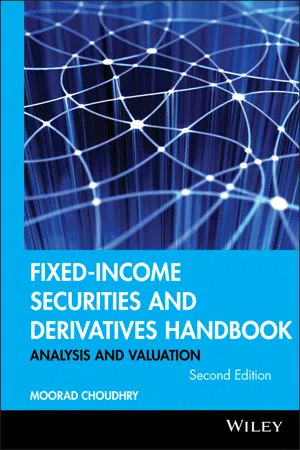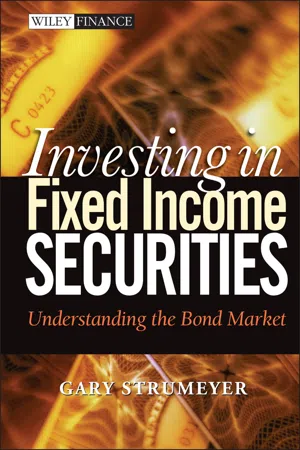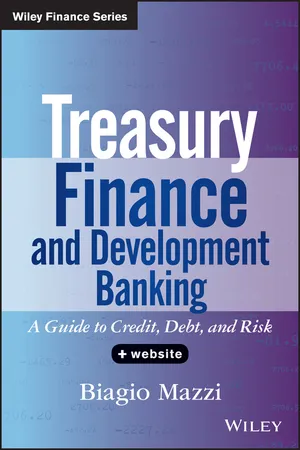Economics
Discount Bond
A discount bond is a bond that is issued for less than its face value, typically because it pays no interest or a lower interest rate than the market rate. Investors purchase discount bonds at a discount to their face value and receive the full face value when the bond matures. The difference between the purchase price and the face value represents the investor's return.
Written by Perlego with AI-assistance
Related key terms
8 Key excerpts on "Discount Bond"
- eBook - ePub
Forbes Guide to the Markets
Becoming a Savvy Investor
- Marc M. Groz(Author)
- 2009(Publication Date)
- Wiley(Publisher)
(You might have thought that only stocks trade on a stock exchange; not true. In fact, two of the original five securities traded in the 1790s under the legendary buttonwood tree were government bonds.) To keep it simple, just remember that bonds and other fixed-income securities may also be referred to as debt securities or sometimes credit instruments. Whenever it will help the flow of explanation, we’ll just call them bonds. Interest versus Discount Some kinds of bonds are designed to pay interest; others are purchased at a discount from their face value, or redemption price. Most long-term bonds are of the former variety. Short-term money market instruments are sold at a discount. So are zero-coupon bonds and strips, which have maturities of up to 30 years. money market instrument Short-term debt obligations such as Treasury bills, certificates of deposit, and commercial paper. Perpetual Bonds It is said that there is an exception to every rule. In the present instance, the rule is that all bonds have a maturity date; the exception is perpetual bonds. Perpetuals, like Peter Pan, never mature. Nor can they be redeemed by their issuer; they pay interest forever. They are also known as annuity bonds. There is only one well-known example of perpetual bonds: the British consols. These were issued in the days when the sun never set on the British empire to help pay off other debt originally incurred during the Napoleonic Wars. Though we’ve never seen one, we’ve heard that consols are still around, as are proposals to issue perpetual U.S. Treasury bonds instead of constantly refunding debt as it matures. That proposal, whatever its merits, is a perpetual nonstarter. The amount of interest that a bond pays as a percentage of its face value (also called principal amount) is called its coupon, or coupon rate. For example, a bond with an 8 percent coupon rate pays $8 for every $100 of face value - eBook - ePub
Fixed-Income Securities and Derivatives Handbook
Analysis and Valuation
- Moorad Choudhry(Author)
- 2010(Publication Date)
- Bloomberg Press(Publisher)
The interest rate used to derive the present value of the cash flows, known as the discount rate, is key, since it reflects where the bond is trading and how its return is perceived by the market. All the factors that identify the bond—including the nature of the issuer, the maturity date, the coupon, and the currency in which it was issued—influence the bond’s discount rate. Comparable bonds have similar discount rates. The following sections explain the traditional approach to bond pricing for plain vanilla instruments, making certain assumptions to keep the analysis simple. After that, a more formal analysis is presented. Basic Features and Definitions One of the key identifying features of a bond is its issuer, the entity that is borrowing funds by issuing the bond in the market. Issuers generally fall into one of four categories: governments and their agencies; local governments, or municipal authorities; supranational bodies, such as the World Bank; and corporations. Within the municipal and corporate markets there are a wide range of issuers that differ in their ability to make the interest payments on their debt and repay the full loan. An issuer’s ability to make these payments is identified by its credit rating. Another key feature of a bond is its term to maturity: the number of years over which the issuer has promised to meet the conditions of the debt obligation. The practice in the bond market is to refer to the term to maturity of a bond simply as its maturity or term. Bonds are debt capital market securities and therefore have maturities longer than one year. This differentiates them from money market securities. Bonds also have more intricate cash flow patterns than money market securities, which usually have just one cash flow at maturity - eBook - ePub
- Frank J. Fabozzi(Author)
- 2012(Publication Date)
- Wiley(Publisher)
As for the importance of the curvature to bond investors, let's consider what happens to bond prices in both falling and rising interest rate environments. First, what happens to bond prices as interest rates fall? The answer is obvious—bond prices rise. How about the rate at which they rise? If the price/discount rate relationship was linear, as interest rates fell, bond prices would rise at a constant rate. However, the relationship is not linear, it is curved and curved inward. Accordingly, when interest rates fall, bond prices increase at an increasing rate. Now, let's consider what happens when interest rates rise. Of course, bond prices fall. How about the rate at which bond prices fall? Once again, if the price/discount rate relationship were linear, as interest rates rose, bond prices would fall at a constant rate. Since it curved inward, when interest rates rise, bond prices decrease at a decreasing rate.Time Path of Bond As a bond moves towards its maturity date, its value changes. More specifically, assuming that the discount rate does not change, a bond's value:With respect to the last property, we are assuming the bond is valued on its coupon anniversary dates.1. Decreases over time if the bond is selling at a premium.2. Increases over time if the bond is selling at a discount.3. Is unchanged if the bond is selling at par value.At the maturity date, the bond's value is equal to its par or maturity value. So, as a bond's maturity approaches, the price of a Discount Bond will rise to its par value and a premium bond will fall to its par value—a characteristic sometimes referred to as pull to par value .ARBITRAGE-FREE BOND VALUATIONThe traditional approach to valuation is to discount every cash flow of a fixed income security using the same interest or discount rate. The fundamental flaw of this approach is that it views each security as the same package of cash flows. For example, consider a 5-year U.S. Treasury note with a 6% coupon rate. The cash flows per $100 of par value would be 9 payments of $3 every six months and $103 ten 6-month periods from now. The traditional practice would discount every cash flow using the same discount rate regardless of when the cash flows are delivered in time and the shape of the yield curve. Finance theory tells us that any security should be thought of as a package or portfolio of zero-coupon bonds.The proper way to view the 5-year 6% coupon Treasury note is as a package of zero-coupon instruments whose maturity value is the amount of the cash flow and whose maturity date coincides with the date the cash flow is to be received. Thus, the 5-year 6% coupon Treasury issue should be viewed as a package of 10 zero-coupon instruments that mature every six months for the next five years. This approach to valuation does not allow a market participant to realize an arbitrage profit by breaking apart or “stripping” a bond and selling the individual cash flows (that is, stripped securities) at a higher aggregate value than it would cost to purchase the security in the market. Simply put, arbitrage profits are possible when the sum of the parts is worth more than the whole or vice versa. Because this approach to valuation precludes arbitrage profits, we refer to it as the arbitrage-free valuation approach - eBook - ePub
Investing in Fixed Income Securities
Understanding the Bond Market
- Gary Strumeyer(Author)
- 2012(Publication Date)
- Wiley(Publisher)
We discussed concepts surrounding the time value of money. We learned about the relationship between present value and future value and we saw how the discount rate affected these values and thus the value of our investment at any given time. Now let’s explore those concepts as they relate to the returns on various investment alternatives. It is important to understand the underlying framework of bond pricing.The name commonly given to the discount rate when speaking in the context of valuing a bond is yield . What, exactly, does yield mean to the investor? By now, we understand its mathematical meaning. We understand its use in the bond pricing formula. We understand that bond prices move in the opposite direction, or inversely, from their yields. But what is yield?Think of yield as a measure of simple return to the investor or trader who purchases a bond at a particular price. Your bond has the price that it does simply because other investors and traders have determined that the bond’s particular characteristics—the size of the coupon, the length of time to maturity, the issuer’s industry and credit rating, and any embedded options—should earn you a certain yield, or simple return, relative to other securities with similar and different characteristics. For example, let’s say the long bond—the U.S. Treasury’s 30-year bellwether bond—is yielding 4.90 percent (for a price of 107). From the standpoint of traders and investors, this yield is the simple return one should earn in today’s economic environment on securities held for 30 years with the highest credit quality (lowest risk of default). The current 30-year bond is the 5.375 percent maturing in February 2031.What else does the yield tell us? It also says that investors require a simple return of 4.90 percent to allow an entity like the U.S. government to hold their money for 30 years. During that time, the money is not available to investors for other investment alternatives. Thus, the yield of the bond represents the opportunity cost of not being able to invest elsewhere. The market as a whole, encompassing all types of participants from traders to portfolio managers, has determined that 4.90 percent is the right yield for a 30-year bond with no default risk and no embedded options. - eBook - ePub
Treasury Finance and Development Banking
A Guide to Credit, Debt, and Risk
- Biagio Mazzi(Author)
- 2013(Publication Date)
- Wiley(Publisher)
CHAPTER 5 Bond PricingWe have built all the tools needed to approach the topic that is at the center of any discussion of credit and the activity of a treasury: debt. We have seen how to generate and discount future cash flows, we have seen how a choice of discounting is highly sensitive to the credit environment, and we have explicitly discussed credit. It is now time to use this knowledge to observe and price debt instruments.In order to build a self-contained narrative we shall begin with an introduction to the basic concepts surrounding a bond. We shall then move on to the very important issue of trying to isolate the credit component of a bond in a more or less explicit way; we shall present the concepts of benchmarks, asset swaps (introduced here and revisited in the following chapters); and an analysis of the relationship between bonds and credit default swaps. We shall conclude with a section on how to price distressed and/or highly illiquid bonds and one where this final topic is presented through a numerical example.5.1 WHAT IS A BOND?We have defined a bond as a way for an entity to raise capital without relinquishing control. Bonds are among the oldest financial instruments and among the first types of securitization,1 a way of turning the scattered revenues of a government or a corporation into a well-defined and tradable instrument. An entity forecasts a fairly regular set of revenues (from sales for a company or from taxes and investments for a government) but needs an immediate and large cash amount: on the back of its revenues it will issue a bond in which it promises to return the amount at maturity and to pay interest at regular dates. The regularity of the entity’s revenues should ensure the regular payment of coupons.An investor will decide to buy a certain amount of this bond (effectively lending money to the entity) and the price for this bond will be driven by the investor’s trust in the entity’s abilities to meet its obligations. The price at a time t of a bond B - eBook - ePub
Interest Rate Markets
A Practical Approach to Fixed Income
- Siddhartha Jha(Author)
- 0(Publication Date)
- Wiley(Publisher)
Chapter 2 BondsBonds are the starting point for understanding the fixed income market. They represent a standardized form of loan between investors and debt holders and form the foundation of the fixed income market. Although bonds are traded in massive volume daily, they are less known to the general public than the stock market. Unlike stocks, which have indefinite maturity and uncertain dividends that can be withdrawn at will by the issuer, bonds have a fixed maturity and fixed interest at inception (or interest that changes according to an agreed-on formula). Furthermore, while stocks are issued mainly by corporations, bonds have a tremendous variety of issuers, including governments, corporations, and homeowners. This chapter introduces the basic characteristics of bonds, their valuation, and the risks of investing in them. Even if the borrower of the debt is sure to repay the loan, there are other risks to consider if bonds are bought and sold in the market. We quantify and attempt to control them, especially when initiating trades beyond simply buying or selling a single bond.BASICS OF BONDSTo understand the details of bonds, first consider a simple case where you lend your friend $5 for a week. In the case of such micro-loans, most of the time the $5 is returned after a week with no adjustment made for interest. However, let's take the example to a larger scale. Assume that you have lent money not to a good friend, but to an institution, such as the government. Also, instead of $5, suppose you have lent $1 million. Finally, instead of a week, suppose the term of the loan is 10 years. In this case, the government promises to return your $1 million after 10 years, probably using it for purposes like defense or social welfare in the meantime. Although lending without interest was okay with the $5 to your friend for a week, this case is obviously very different. With the government, you are unlikely to just hand over $1 million today and be satisfied with getting it back after 10 years. To see why this is so, consider what else could have been done with the $1 million. To be sure, you could choose to consume it now rather than wait 10 years. Or you could invest the money in a stock and, perhaps, realize large gains if the stock market rises. Finally, if choosing a safe route, you could have saved it in a bank and earned interest in a savings account. Given all these different choices, it is then not unreasonable for the investor to demand that interest be given in return for lending the $1 million to the government. - eBook - ePub
The Handbook of Traditional and Alternative Investment Vehicles
Investment Characteristics and Strategies
- Mark J. P. Anson, Frank J. Fabozzi, Frank J. Jones(Authors)
- 2010(Publication Date)
- Wiley(Publisher)
CHAPTER 4Bond BasicsIn its simplest form, a bond is a financial obligation of an entity that promises to pay a specified sum of money at specified future dates. The payments are made up of two components: (1) the repayment of the amount of money borrowed and (2) interest. The entity that promises to make the payment is called the issuer of the security or the borrower. We provide the basic features of bonds and the risks associated with investing in this asset class in this chapter. In subsequent chapters we provide details on specific sectors of the bond market.FEATURES OF BONDS
In the following sections, we describe the basic features of bonds.Maturity
Unlike common stock, which has a perpetual life, bonds have a date on which they mature. The number of years over which the issuer has promised to meet the conditions of the obligation is referred to as the term to maturity. The maturity of a bond refers to the date that the debt will cease to exist, at which time the issuer will redeem the bond by paying the amount borrowed. The maturity date of a bond is always identified when describing a bond. For example, a description of a bond might state “due 12/15/2025.”The maturity of a bond is used for classifying two sectors of the market. Debt instruments with a maturity of one year or less are referred to as money market instruments and trade in the money market. What we typically refer to as the “bond market” includes debt instruments with a maturity greater than one year. The bond market is then categorized further based on the bond’s term to maturity: short-term, intermediate-term, and long-term. The classification is somewhat arbitrary and varies amongst market participants. A common classification is that short-term bonds have a maturity of from one to five years, intermediate-term bonds have a maturity from five to 12 years, and long-term bonds - eBook - ePub
Fixed Income Securities
Concepts and Applications
- Sunil Kumar Parameswaran(Author)
- 2019(Publication Date)
- De Gruyter(Publisher)
The issue of interest is the spread between the yield on the new security and that on the outstanding security. If a dealer “gives” 10 basis points (bp) in a roll, it means that the WI security has a YTM that is higher by 10 bp compared to the existing security. On the contrary, if a dealer “takes” 10 bp in a roll, it means that the WI security has a YTM that is lower by 10 bp compared to the outstanding issue.Accounting for Bonds
Bonds are typically issued at par, but may be issued at a premium or at a discount. Accounting for a par bond issue is fairly simple. Assume Alpha Corporation issues 1,000 JD-15 bonds on 15 June 2018. The face value is $1,000, the coupon is 10% per annum paid semiannually, and the time to maturity is three years. When the bonds are issued, there is an inflow of cash. Thus cash, which is an asset, is debited with $1,000,000, and bonds payable, a liability is credited with $1,000,000. On the first coupon date which is 15 December 2018, the total interest payable is $50,000. Bond interest expenses is debited with $50,000. If the payout is immediate, cash is credited with $50,000. Otherwise, interest payable is credited with $50,000.Issue of Discount Bonds
Now assume that while the coupon continues to remain at 10% per annum, the YTM at the time of issue is 12%. The bond will obviously trade at a discount. The price will be $950.8268. If 1,000 bonds are issued, the cash inflow will be $950,827. Thus cash will be debited with this amount. Bonds payable will be credited with $1,000,000. Unamortized bond discount will be debited with the difference, which is $49,173. This discount has to be amortized, or written off, during the life of the bond. Thus the discount will steadily decline, and the carrying value, which is the difference between the face value and the unamortized discount, will steadily increase. At the time of maturity of the bond, the unamortized discount will be zero, and the carrying value will be equal to the face value. When a company issues a bond at a discount, the effective interest paid is greater than the coupon rate. This is because at the outset, the issuer receives an amount less than the face value, whereas at maturity it has to pay the entire face value. Thus the discount must be added to the total coupon paid, in order to arrive at the effective interest. In our illustration, the total coupon paid over three years is $300,000. The discount is $49,173. Thus the total interest cost is $349,173. The discount is allocated over the life of the security. Thus every period, the interest expense will be equal to the coupon interest paid, plus the amortized discount. This procedure is called amortization of bond discount. There are two approaches, the straight line method (SLM) and the effective interest method (EIM). We discuss both in the following sections.11
Learn about this page
Index pages curate the most relevant extracts from our library of academic textbooks. They’ve been created using an in-house natural language model (NLM), each adding context and meaning to key research topics.







